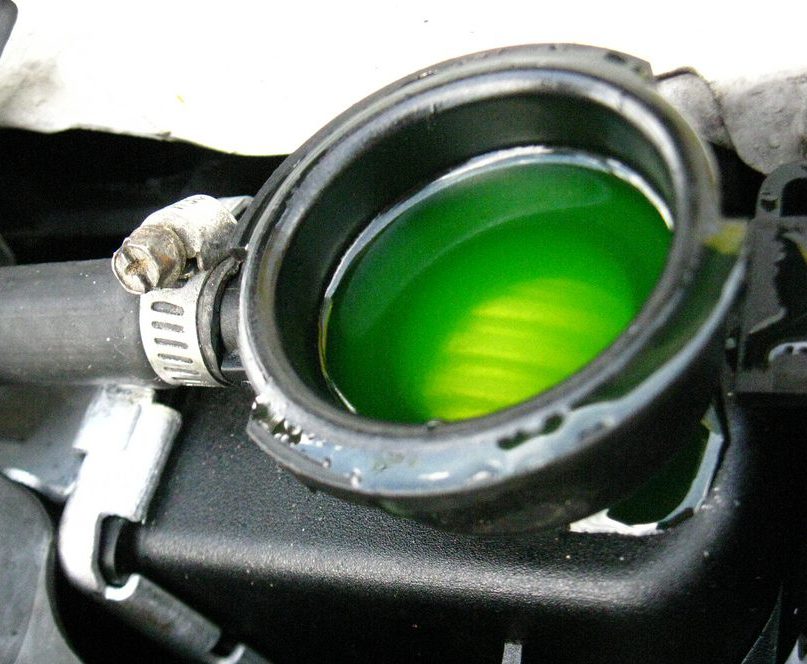Shakes, rattles, squeaks & thunks…(Anti-freeze)

We have an inherent nature within each one of us that tends to put important things off. When it comes to maintaining our vehicle’s health, we know certain things need to be done, but the prevailing attitude for most of us seems to be: “I’ll get around to it later, …not right now.” Does that sum up your attitude, for the most part? It does for me.
The winter cold will soon be upon us and whether we like it or not, it’s time to check the condition of our vehicle’s anti-freeze. Our car or truck’s coolant condition tends to be a low priority item, and other than giving the level on the side of the opaque overflow bottle a casual glance to see if it is within the cold and hot range, we tend to ignore it. We give a much higher priority to the oil level in our vehicles as we gas up at any full-serve station, when the attendant asks you if he or she should check the oil.
“It is very important,” says Mendonza, “to check the condition of your vehicle’s coolant.” Traditionally the green or ethylene glycol based coolant, by far is the most predominant anti-freeze available. “The green colour,” Oliver continues, “results from a dye being added to distinguish the product as being anti-freeze.”
Anti-freeze has a life span of only two years because it decomposes. It loses its protection agencies and begins to form acids. “These acids,” states Mendonza, “will react with your car’s radiator, aluminum head, head gasket and hoses.”
The first step is to check the coolant level in your car or truck’s expansion bottle. If no coolant is visible, then open the plastic cap and have a look inside. Sometimes the opaque bottle may be too dirty to see the coolant level from the outside. If the bottle is empty, you may have a coolant leak, or if you haven’t checked it for six months or so, it may have evaporated. Next, open the radiator cap (only if the engine is cold) and if the coolant level is up to the top, you’re OK. Fill the expansion tank with a mix of 50% anti-freeze and 50% water.
To determine if there is a coolant leak on your vehicle, first inspect the water pump, which is usually located in front and center of your engine block. It has a fan pulley and two radiator hoses attached to it. “If you can,” informs Oliver, “look underneath the water pump and you may see a little hole. “On some cars you can see the hole, on others you cannot. If there is a leak,” continues Mendonza, “you will see a leak there.” Telltale signs of a water pump leak may be watermarks or lines that will be visible on the crankshaft pulley or engine tray, etc. That is where you may have lost your coolant from the expansion bottle.
“In most cases,” he emphasizes, “the water pump will have to be replaced.” To confirm if your water pump is the cause of your coolant leaking problem, have your radiator pressure tested. If the water pump isn’t suspect, run the engine and inspect the upper and lower radiator hoses for leaks as well as the heater hoses. The problem might be as simple as a loose clamp that needs to be tightened.
Other hoses that should be checked are small hoses that may run in a carburated vehicle to warm up the thermostat, or that warm up the idle valve regulator on a fuel injected car. If you don’t detect any leaks, top up the expansion bottle and check it again in a couple of weeks.
“The second point regarding the coolant in your car or truck,” emphasizes Oliver, “ is to check the colour of the anti-freeze. This is very important.” New anti-freeze will have a bright green colour whereas coolant that has been in the vehicle for two or more years will have a brownish-green appearance because it has decomposed. “This is a very good indication,” Mendonza continues, “that the antifreeze needs to be changed.” A good rule of thumb is to change the coolant in your vehicle every two years. After two years anti-freeze becomes acidic and can eat away at the water pump impeller, ruin head gaskets, and cause sludge to build up in the radiator and heater core, which can lead to the cooling system overheating.
If you are still not certain if your anti-freeze is good or bad take your car to a reputable garage and have the mechanic check the coolant with a refractometer. This device will shine a little light through your coolant and measures the opacity of the anti-freeze. A graduated number scale will determine how clean or dirty your coolant is. If it is borderline, it is time for a coolant flush. Before flushing the coolant it would be wise to have the system pressure tested to ensure there are no leaks in the system before new anti-freeze is put in.
While you are checking the coolant at this time of the year, check the fan belt or serpentine belt to make sure it is tight. Have your mechanic do a load test on your vehicle’s battery to make sure its’ condition will see you through another winter. If instead of showing 12 or 13 volts, it is indicating 9 volts, then it will have to be replaced. Lastly, check the starter motor current draw and alternator charging output to ensure those important components are working properly.
Doing those checks on your vehicle should ensure some peace of mind, knowing that you’ve taken the necessary steps to ensure a trouble free winter. Happy motoring!




